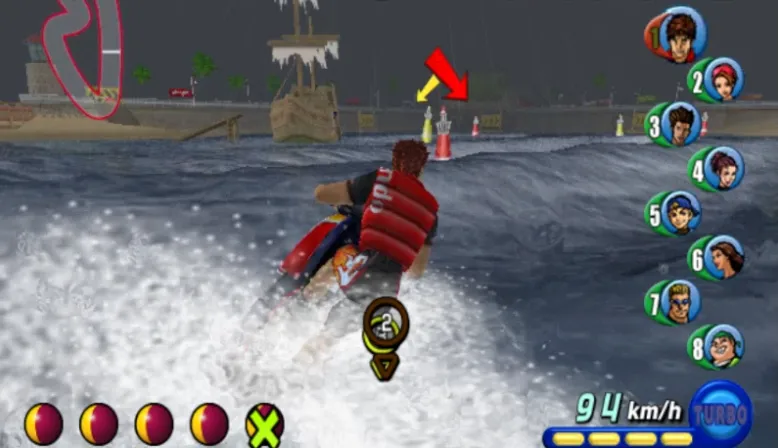

Well, I did say I would eventually get to talking about this one.
With how I'd like to save up my complete thoughts of the game later on with a more in-depth runthrough of all its aspects, not just on what makes it stand out for those that dive deep into it...but also what has made it seem lesser [or even in a few aspects, be lesser] than its often more praised predecessor, Wave Race 64, I'll go on the bullet points of what the game offers, what the game adds, and where the difficulty lies on this one.
More training material before diving into familiar modes
Not only the game includes a Tutorial option in the main menu that goes over all the basic controls and even the inputs for tricks [which you'd have to look up on the manual or online for Wave Race 64], but also has you try the Exhibition first before actually diving in the first Normal circuit when you try the championship mode.
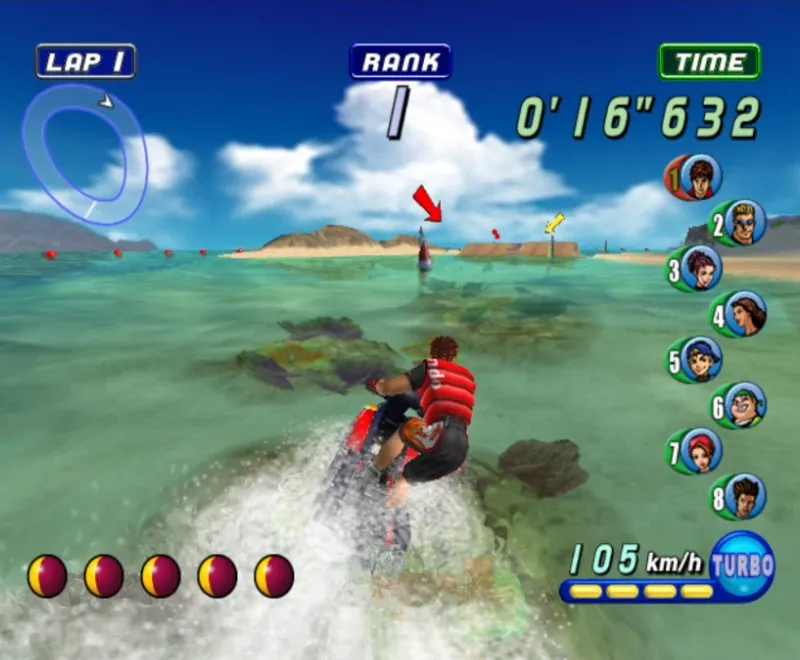
Wave Race 64 had the optional warm-up mode in Normal difficulty that let you drive around the wide Dolphin Park and follow a dolphin for practice [which could even get you an easter egg or two], but Blue Storm wants you to try for a proper race from the get go before opening the gates.
With or without having cleared that though, you should still have access to Time Attack and Stunt Mode, the former being self-explanatory, while the latter being as it was in Wave Race 64: A mode where you have to drive through rings on the track and use any of the added ramps to do tricks, with the goal of getting a high score.
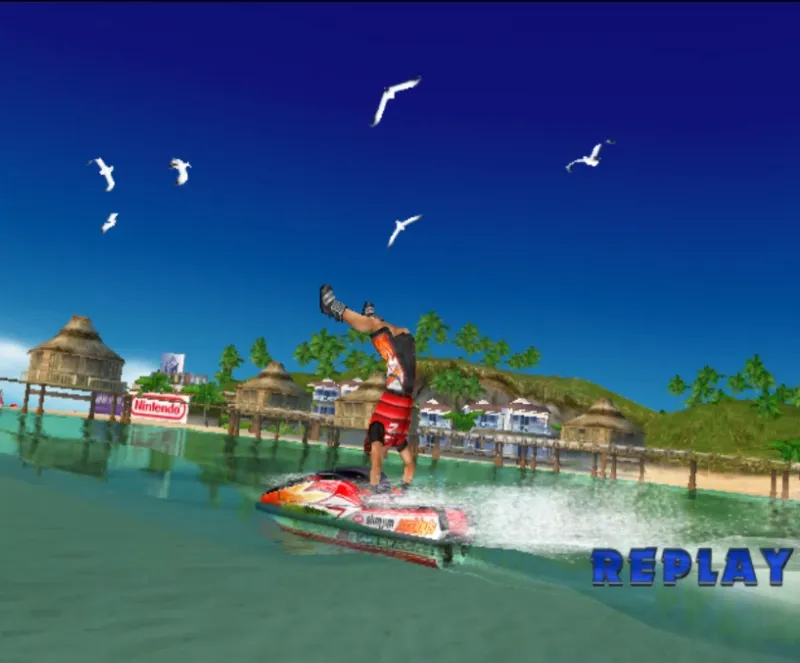
So...if the game has the same modes Wave Race 64 offered, and is a sequel to that game, then it means it should be just as much of a breezy cruise to get started with?
When the waves are on, the gloves come off
If there's a few factors that influenced in Wave Race Blue Storm being often less fondly remembered if not remembered at all than Wave Race 64...it may be down to the difficulty and vibes - but I'll go on the difficulty first.

Unlike the 64 game, Blue Storm is immediately tougher to handle for a newcomer, with the waterbike jumping more frequently from small waves and making the handling harder to control, mainly in the aspect of doing sharp turns in time.
While Wave Race 64 had the challenge of swerving through buoys through steering the right time [and that was with the heavier characters - lighter ones in that game steer VERY quickly but require precision with the analog stick to not overshoot often], the steering was smooth when you got a handle on it on calm waters, leaving the more noticeable waves as obstacles for you to deal with.
You can steer smoothly in Blue Storm if the water is calm, but not only you'll had to make sure to steer in anticipation before sharp turns due to the time it can take for the rider to turn the waterbike, but also needing to let go of the accel if the waves start making your waterbike jump around too much on a section where you need to slalom through buoys.
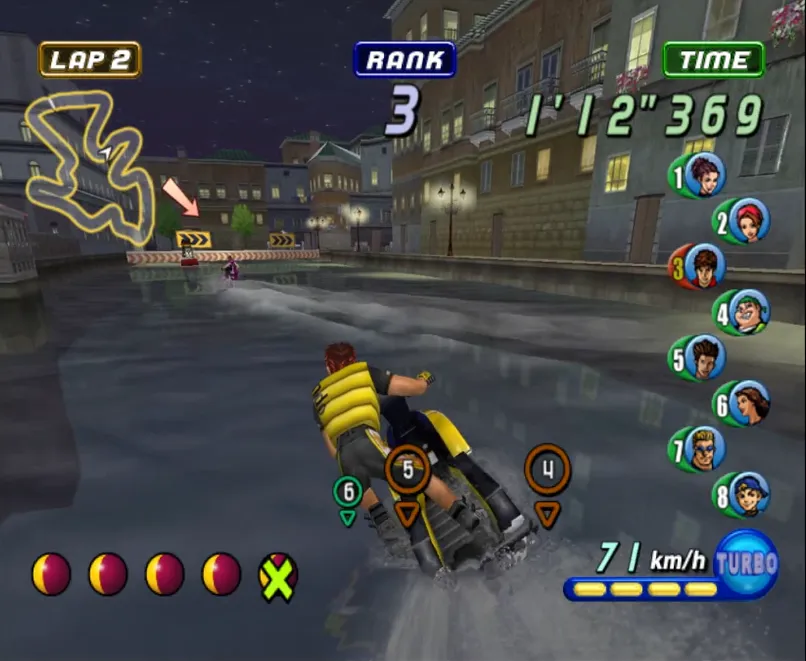
That, on top of the CPUs being noticeably tougher to shake off consistently, leaving you with less margin of error even in the Normal circuit than what the N64 game would do and the buoys in the tracks similarly getting tougher and tougher early on, and you have a game that will kick you while down as much as it wants unless you are willing to practice and grit through it.
And yes, the point system to advance in races is still there - good luck.
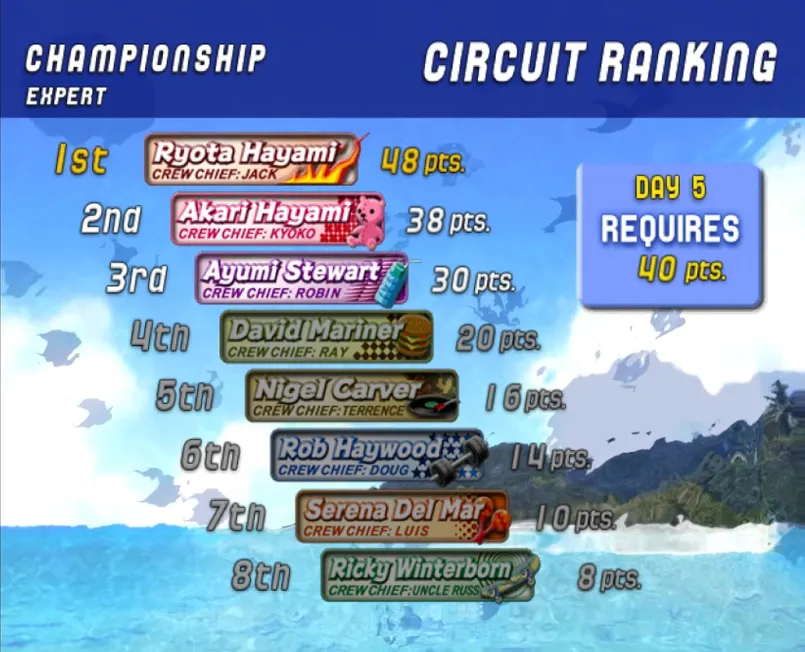
Weather sure plays a factor in waves being hard to control, but on the list of additions that you get to help yourself on the go...
Some old tricks that still work, some new ones that may help a lot
Not only some of the classic trick inputs from WR64 still work [like the handstand and backwards spin], but so does holding down while steering for sharper turns.
Using the non-ramp tricks may be useful in straights whenever you're one off from maximum power...or should I say, the Turbo.
Replacing the old system of increasing your accel and speed with consecutive buoys passed properly, passing buoys here instead builds on a gauge that lets you unleash a Turbo - good for straights and for buoy skips in specific places, but not something you should use if in need to maneuver carefully through buoys or before a sharp turn.
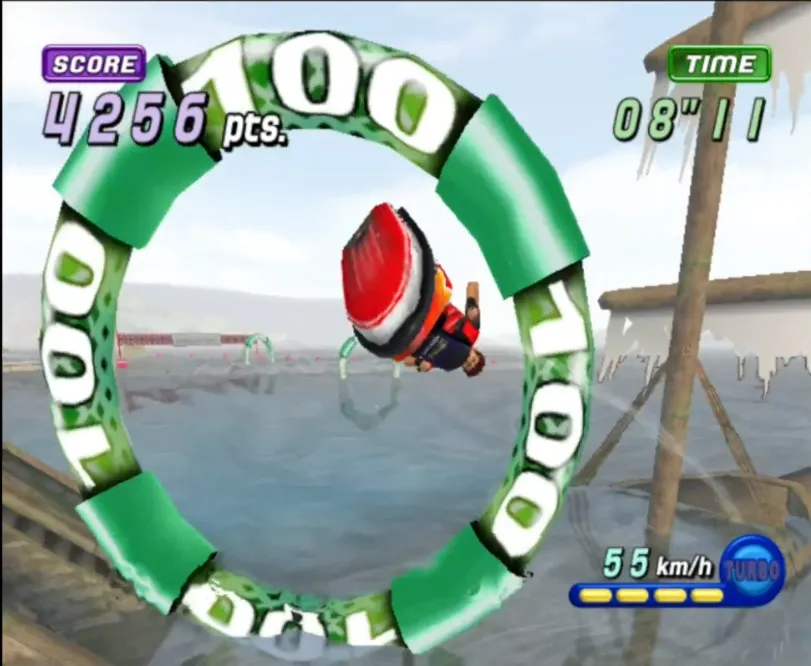
Thing is, doing tricks in this game now adds to this gauge as well, so if you get four pegs in a section but need one more for Turbo, doing a handstand or backwards spin will get you the last one needed for you to boost away.
In this game's Stunt Mode, it also means that you can use those tricks to stock up on turbo for whenever you need some more speed to go off a high ramp and do a flip, which is neat...because as there are no buoys in Stunt Mode, you only get to charge the Turbo through tricks and pressing A right as the race starts.
Veredict so far
If the first thing that has made Blue Storm often be less fondly remembered than 64 by most out there is the steeper difficulty slope to take on from the get go, then the second thing is how it doesn't have the same energy as the previous game - down to the music being more on the rock or tropical side, and not having the bombastic announcer of the original either.
If it seems like a more intentionally western 2000s take on Wave Race...that's because its very much literally that, even with the developer being the american-based Nintendo Software Technology, rather than being handled by the Nintendo EAD team with Shigeru Miyamoto in the case of Wave Race 64.
I haven't properly mentioned it yet until now but...despite the way I've been describing it on why it lives on the shadow of the 64 game, I actually like Wave Race Blue Storm - even if the music isn't as memorable, as I've kind of got hooked by the kind of difficulty this game posed, in the same way that Wave Race 64's Expert and Reverse Championships did [and even going for a challenge run on Expert where I had to get all 1st place finishes].
The game can be unforgiving for sure, whether you wipe out with a collision on an object [or even worse if unlucky - get stuck in it] or mess up a turn and get overtaken by a CPU conveniently close to you, and more so on the harder tracks that don't fool around, but it sure scratched that itch for a steep challenge to eventually overcome that's consistently more demanding than Wave Race 64.
A more concisely brief post than usual for me, but it can come in handy to practice making stuff more compact to read and understand - even if I'll later have to spend more time digging my thoughts to talk further in-depth if I decide to follow up on this one.
But hey, I hope you had enjoyed reading this. Is it the first time you hear of this game? Or had you seen or even played it before?
Thanks for reading, and see you next time.

Spanish translation with DeepL. All screenshots were captured by myself.
Español
Bueno, la ultima vez dije que al final hablaría de este juego.
Como me gustaría guardar mis opiniones completas sobre el juego para más adelante, con un análisis más profundo de todos sus aspectos, no solo de lo que lo hace destacar para aquellos que se sumergen en él... sino también lo que lo ha hecho parecer inferior [o incluso, en algunos aspectos, ser inferior] a su predecesor, Wave Race 64, que suele recibir más elogios, voy a enumerar los puntos clave de lo que ofrece el juego, lo que añade y dónde reside la dificultad en este caso.
Más material de entrenamiento antes de sumergirse en los modos familiares
El juego no solo incluye una opción de tutorial en el menú principal que repasa todos los controles básicos e incluso las entradas para los trucos [que en Wave Race 64 había que buscar en el manual o en Internet], sino que también te permite probar primero la Exhibición antes de sumergirte en el primer circuito Normal cuando pruebas el modo campeonato.

Wave Race 64 tenía un modo de calentamiento opcional en dificultad Normal que te permitía conducir por el amplio Dolphin Park y seguir a un delfín para practicar [lo que incluso podía darte uno o dos huevos de Pascua], pero Blue Storm quiere que pruebes una carrera propiamente dicha desde el principio antes de abrir las puertas.
Sin embargo, independientemente de si lo has superado o no, deberías seguir teniendo acceso al modo Contrarreloj y al modo Acrobacias, el primero de los cuales se explica por sí mismo, mientras que el segundo es igual que en Wave Race 64: un modo en el que tienes que conducir a través de aros en la pista y utilizar cualquiera de las rampas añadidas para hacer acrobacias, con el objetivo de conseguir una puntuación alta.

Entonces... si el juego tiene los mismos modos que ofrecía Wave Race 64 y es una secuela de ese juego, ¿significa que debería ser igual de fácil empezar a jugar?
Cuando las olas están altas, se quitan los guantes
Si hay algunos factores que influyeron en que Wave Race Blue Storm sea menos recordado, o incluso olvidado, que Wave Race 64... puede que se deba a la dificultad y al ambiente, pero voy a hablar primero de la dificultad.

A diferencia del juego de 64, Blue Storm es inmediatamente más difícil de manejar para un principiante, ya que la moto acuática salta con más frecuencia por las pequeñas olas y hace que el manejo sea más difícil de controlar, sobre todo a la hora de realizar giros bruscos a tiempo.
Mientras que Wave Race 64 tenía el reto de esquivar boyas girando en el momento adecuado [y eso era con los personajes más pesados; los más ligeros en ese juego giran MUY rápido, pero requieren precisión con el joystick analógico para no sobrepasar la curva con frecuencia], la dirección era suave cuando se dominaba en aguas tranquilas, dejando las olas más notables como obstáculos con los que lidiar.
En Blue Storm se puede conducir con suavidad si el agua está en calma, pero no solo hay que asegurarse de girar con anticipación antes de los giros bruscos debido al tiempo que puede tardar el piloto en girar la moto acuática, sino que también hay que soltar el acelerador si las olas empiezan a hacer que la moto acuática salte demasiado en una sección en la que hay que hacer eslalon entre las boyas.

Eso, además de que las CPU son notablemente más difíciles de esquivar de forma consistente, lo que te deja con menos margen de error incluso en el circuito Normal que en el juego de N64, y las boyas en las pistas también se vuelven cada vez más difíciles desde el principio, y tienes un juego que te dará una paliza tanto como quiera a menos que estés dispuesto a practicar y esforzarte.
Y sí, el sistema de puntos para avanzar en las carreras sigue ahí. ¡Buena suerte!

El clima sin duda influye en la dificultad para controlar las olas, pero en la lista de novedades que te ayudarán sobre la marcha...
Algunos trucos antiguos que siguen funcionando, otros nuevos que pueden ser muy útiles
No solo siguen funcionando algunos de los trucos clásicos de WR64 [como el pino y el giro hacia atrás], sino que también sirve mantener pulsado mientras se gira para tomar curvas más cerradas.
Usar los trucos sin rampa puede ser útil en rectas cuando te falta un poco para alcanzar la potencia máxima... o debería decir, el turbo.
En lugar del antiguo sistema de aumentar la aceleración y la velocidad pasando correctamente por boyas consecutivas, aquí pasar por las boyas se acumula en un medidor que te permite activar el Turbo, lo cual es bueno para rectas y para saltar boyas en lugares específicos, pero no es algo que debas usar si necesitas maniobrar con cuidado entre boyas o antes de un giro brusco.

La cuestión es que ahora hacer trucos en este juego también añade a este medidor, así que si consigues cuatro clavijas en una sección pero necesitas una más para el turbo, hacer una parada de manos o un giro hacia atrás te dará la última que necesitas para acelerar.
En el modo Stunt de este juego, esto también significa que puedes usar esos trucos para acumular turbo para cuando necesites más velocidad para saltar una rampa alta y hacer un salto mortal, lo cual es genial... porque como no hay boyas en el modo Stunt, solo puedes cargar el turbo mediante trucos y pulsando A justo cuando comienza la carrera.
Veredicto hasta ahora
Si lo primero que ha hecho que Blue Storm sea menos recordado que 64 por la mayoría es la mayor dificultad desde el principio, lo segundo es que no tiene la misma energía que el juego anterior, ya que la música es más rockera o tropical y tampoco cuenta con el grandilocuente locutor del original.
Si parece una versión más occidental de Wave Race de la década de 2000... es porque, literalmente, lo es, ya que el desarrollador es Nintendo Software Technology, con sede en Estados Unidos, en lugar de ser el equipo EAD de Nintendo con Shigeru Miyamoto, como en el caso de Wave Race 64.
No lo he mencionado adecuadamente hasta ahora, pero... a pesar de cómo lo he descrito, explicando por qué vive a la sombra del juego de 64, en realidad me gusta Wave Race Blue Storm, aunque la música no sea tan memorable, ya que me ha enganchado el tipo de dificultad que plantea este juego, al igual que lo hicieron los campeonatos Expert y Reverse de Wave Race 64 [e incluso intentando completar el modo Expert, en el que tenía que quedar en primer lugar en todas las carreras].
El juego puede ser implacable, sin duda, ya sea porque te estrellas contra un objeto [o, peor aún, si tienes mala suerte, te quedas atascado en él] o porque fallas en un giro y te adelanta un rival controlado por la CPU que se encuentra convenientemente cerca de ti, y más aún en las pistas más difíciles, que no dan tregua, pero sin duda satisfizo mi ansia de un desafío difícil de superar que es constantemente más exigente que Wave Race 64.
Una entrada más concisa de lo habitual para mí, pero puede ser útil para practicar cómo hacer las cosas más compactas para leer y entender, aunque luego tenga que dedicar más tiempo a profundizar en mis pensamientos para hablar más en profundidad si decido continuar con este tema.
Pero bueno, espero que hayas disfrutado leyendo esto. ¿Es la primera vez que oyes hablar de este juego? ¿O lo habías visto o incluso jugado antes?
Gracias por leer y hasta la próxima.

Traducción al español hecha con DeepL. Todas las fotos capturadas por mí.
